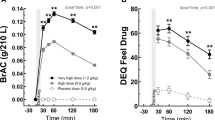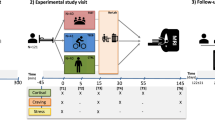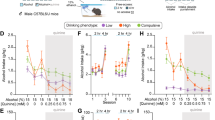Abstract
The Allostatic Model proposes that Alcohol Use Disorder (AUD) is associated with a transition in the motivational structure of alcohol drinking: from positive reinforcement in early-stage drinking to negative reinforcement in late-stage dependence. However, direct empirical support for this preclinical model from human experiments is limited. This study tests predictions derived from the Allostatic Model in humans. Specifically, this study tested whether alcohol use severity (1) independently predicts subjective responses to alcohol (SR; comprised of stimulation/hedonia, negative affect, sedation and craving domains), and alcohol self-administration and 2) moderates associations between domains of SR and alcohol self-administration. Heavy drinking participants ranging in severity of alcohol use and problems (N = 67) completed an intravenous alcohol administration paradigm combining an alcohol challenge (target BrAC = 60 mg%), with progressive ratio self-administration. Alcohol use severity was associated with greater baseline negative affect, sedation, and craving but did not predict changes in any SR domain during the alcohol challenge. Alcohol use severity also predicted greater self-administration. Craving during the alcohol challenge strongly predicted self-administration and sedation predicted lower self-administration. Neither stimulation, nor negative affect predicted self-administration. This study represents a novel approach to translating preclinical neuroscientific theories to the human laboratory. As expected, craving predicted self-administration and sedation was protective. Contrary to the predictions of the Allostatic Model, however, these results were inconsistent with a transition from positively to negatively reinforced alcohol consumption in severe AUD. Future studies that assess negative reinforcement in the context of an acute stressor are warranted.
Similar content being viewed by others
Log in or create a free account to read this content
Gain free access to this article, as well as selected content from this journal and more on nature.com
or
References
Koob GF, Kenneth Lloyd G, Mason BJ. Development of pharmacotherapies for drug addiction: a Rosetta Stone approach. Nat Rev Drug Discov. 2009;8:500–15.
Koob GF, Kreek MJ. Stress, dysregulation of drug reward pathways, and the transition to drug dependence. Am J Psychiatry. 2007;164:1149–59.
Koob GF, Le Moal M. Drug abuse: hedonic homeostatic dysregulation. Science. 1997;278:52–8.
Koob GF, Volkow ND. Neurocircuitry of addiction. Neuropsychopharmacology. 2009;35:217–38.
Heinz A, Löber S, Georgi A, Wrase J, Hermann D, Rey E-R, et al. Reward craving and withdrawal relief craving: assessment of different motivational pathways to alcohol intake. Alcohol Alcohol. 2003;38:35–9.
Meinhardt MW, Sommer WH. Postdependent state in rats as a model for medication development in alcoholism. Addict Biol. 2015;20:1–21.
O’Dell LE,Roberts AJ,Smith RT,Koob GF, Enhanced alcohol self-administration after intermittent versus continuous alcohol vapor exposure. alcohol. Alcohol Clin Exp Res. 2004;28:1676–82.
Schulteis G, Liu J. Brain reward deficits accompany withdrawal (hangover) from acute ethanol in rats. Alcohol. 2006;39:21–8.
Schulteis G, Markou A, Cole M, Koob GF. Decreased brain reward produced by ethanol withdrawal. Proc Natl Acad Sci. 1995;92:5880–4.
Rimondini R, Arlinde C, Sommer W, Heilig M. Long-lasting increase in voluntary ethanol consumption and transcriptional regulation in the rat brain after intermittent exposure to alcohol. FASEB J. 2002;16:27–35.
Valdez GR, Roberts AJ, Chan K, Davis H, Brennan M, Zorrilla EP, et al. Increased ethanol self-administration and anxiety-like behavior during acute ethanol withdrawal and protracted abstinence: regulation by corticotropin-releasing factor. Alcohol Clin Exp Res. 2002;26:1494–501.
Morean ME, Corbin WR. Subjective response to alcohol: a critical review of the literature. Alcohol Clin Exp Res. 2010;34:385–95.
Quinn PD, Fromme K. Subjective response to alcohol challenge: a quantitative review. Alcohol Clin Exp Res. 2011;35:1759–70.
Schuckit MA. Subjective responses to alcohol in sons of alcoholics and control subjects. Arch Gen Psychiatry. 1984;41:879–84.
Schuckit MA. Low level of response to alcohol as a predictor of future alcoholism. Am J Psychiatry. 1994;151:184–9.
Schuckit MA, Smith TL. An 8-year follow-up of 450 sons of alcoholic and control subjects. Arch Gen Psychiatry. 1996;53:202–10.
Lutz JA, Childs E. Test–retest reliability of the underlying latent factor structure of alcohol subjective response. Psychopharmacol (Berl). 2017;234:1209–16.
Ray LA, MacKillop J, Leventhal A, Hutchison KE. Catching the alcohol buzz: an examination of the latent factor structure of subjective intoxication. Alcohol Clin Exp Res. 2009;33:2154–61.
Bujarski S, Hutchison KE, Roche DJO, Ray LA. Factor structure of subjective responses to alcohol in light and heavy drinkers. Alcohol Clin Exp Res. 2015b;39:1193–202..
King AC, de Wit H, McNamara PJ, Cao D. Rewarding, stimulant, and sedative alcohol responses and relationship to future binge drinking. Arch Gen Psychiatry. 2011;68:389–99.
King AC, McNamara PJ, Hasin DS, Cao D. Alcohol challenge responses predict future alcohol use disorder symptoms: a 6-year prospective study. Biol Psychiatry. 2014;75:798–806.
King AC, Hasin D, O’Connor SJ, McNamara PJ, Cao D. A prospective 5-year re-examination of alcohol response in heavy drinkers progressing in alcohol use disorder. Biol Psychiatry. 2016;79:489–98.
Bujarski S, Hutchison KE, Prause N, Ray LA. Functional significance of subjective response to alcohol across levels of alcohol exposure. Addict Biol. 2015a. https://doi.org/10.1111/adb.12293.
Bujarski S, Ray LA. Subjective response to alcohol and associated craving in heavy drinkers vs. alcohol dependents: An examination of Koob’s allostatic model in humans. Drug Alcohol Depend. 2014a. https://doi.org/10.1016/j.drugalcdep.2014.04.015.
Wardell JD, Ramchandani VA, Hendershot CS. A multilevel structural equation model of within- and between-person associations among subjective responses to alcohol, craving, and laboratory alcohol self-administration. J Abnorm Psychol. 2015;124:1050–63.
Sullivan JT, Sykora K, Schneiderman J, Naranjo CA, Sellers EM. Assessment of alcohol withdrawal: the revised clinical institute withdrawal assessment for alcohol scale (CIWA-Ar). Br J Addict. 1989;84:1353–7.
Plawecki MH, Han J-J, Doerschuk PC, Ramchandani VA, O’Connor SJ. Physiologically based pharmacokinetic (PBPK) models for ethanol. Biomed Eng IEEE Trans On. 2008;55:2691–700.
Zimmermann US, Mick I, Vitvitskyi V, Plawecki MH, Mann KF, O’Connor S. Development and pilot validation of computer-assisted self-infusion of ethanol (case): a new method to study alcohol self-administration in humans. Alcohol Clin Exp Res. 2008;32:1321–8.
Zimmermann US, Mick I, Laucht M, Vitvitskiy V, Plawecki MH, Mann KF, et al. Offspring of parents with an alcohol use disorder prefer higher levels of brain alcohol exposure in experiments involving computer-assisted self-infusion of ethanol (CASE). Psychopharmacology. 2009;202:689–97.
Zimmermann US, O’Connor SJ, Ramchandani VA. Modeling alcohol self-administration in the human laboratory. Behav Neurobiol Alcohol Addict. 2013;13:315–53.
First MB. Structured clinical interview for DSM-IV-TR Axis I disorders: patient edition. Biometrics Research Department, Columbia University, New York, New York, USA; 2005.
Sobell LC, Sobell MB, Leo GI, Cancilla A. Reliability of a timeline method: assessing normal drinkers’ reports of recent drinking and a comparative evaluation across several populations. Br J Addict. 1988;83:393–402.
Skinner HA, Allen BA. Alcohol dependence syndrome: measurement and validation. J Abnorm Psychol. 1982;91:199.
Allen JP, Litten RZ, Fertig JB, Babor T. A review of research on the alcohol use disorders identification test (AUDIT). Alcohol Clin Exp Res. 1997;21:613–9.
Flannery BA, Volpicelli JR, Pettinati HM. Psychometric properties of the penn alcohol craving scale. Alcohol Clin Exp Res. 1999;23:1289–95.
Anton RF. Obsessive–compulsive aspects of craving: development of the Obsessive Compulsive Drinking Scale. Addiction. 2000;95:211–7.
Mann RE, Sobell LC, Sobell MB, Pavan D. Reliability of a family tree questionnaire for assessing family history of alcohol problems. Drug Alcohol Depend. 1985;15:61–7.
Beck AT, Steer RA, Brown GK. Manual for the Beck depression inventory-II. San Antonio TX Psychol Corp. 1996;1:82.
Martin CS, Earleywine M, Musty RE, Perrine MW, Swift RM. Development and validation of the biphasic alcohol effects scale. Alcohol Clin Exp Res. 1993;17:140–6.
McNair D, Lorr M, Droppleman LF. Profile of mood states. San Diego Calif. 1992;53:6.
Bohn MJ, Krahn DD, Staehler BA. Development and initial validation of a measure of drinking urges in abstinent alcoholics. Alcohol Clin Exp Res. 1995;19:600–6.
Kim J-S. Multilevel analysis: An overview and some contemporary issues. In: Roger EM, Alberto M-O. editors. The SAGE handbook of quantitative methods in psychology. London: SAGE; 2009. p. 337-61. Accessed date 1/24/2018.
R Development Core Team. R: a language and environment for statistical computing. Vienna, Austria: R Foundation for Statistical Computing. 2008. http://www.R-project.org. Accessed date 3/12/2017.
Bliese P. Multilevel: multilevel functions. 2013. https://CRAN.R-project.org/package=multilevel. Accessed date 3/12/2017.
Wickham H. ggplot2: elegant graphics for data analysis. New York: Springer-Verlag. 2009. http://ggplot2.org. Accessed date 3/12/2017.
Mason BJ, Light JM, Williams LD, Drobes DJ. Proof-of-concept human laboratory study for protracted abstinence in alcohol dependence: effects of gabapentin. Addict Biol. 2009;14:73–83.
Stangl BL, Vatsalya V, Zametkin MR, Cooke ME, Plawecki MH, O’Connor S, et al. Exposure-response relationships during free-access intravenous alcohol self-administration in nondependent drinkers: influence of alcohol expectancies and impulsivity. Int J Neuropsychopharmacol. 2017;20:31–9.
Bujarski S, Ray LA. Negative affect is associated with alcohol, but not cigarette use in heavy drinking smokers. Addict Behav. 2014b;39:1723–9..
Carpenter KM, Hasin DS. Drinking to cope with negative affect and DSM-IV alcohol use disorders: a test of three alternative explanations. J Stud Alcohol. 1999;60:694–704.
Greeley J, Oei T. Alcohol and tension reduction. Psychol Theor Drink Alcohol. 1999;2:14–53.
Jackson KM, Sher KJ. Alcohol use disorders and psychological distress: a prospective state-trait analysis. J Abnorm Psychol. 2003;112:599.
Newlin DB, Thomson JB. Alcohol challenge with sons of alcoholics: A critical review and analysis. Psychol Bull. 1990;108:383–402.
American Psychiatric Association. Diagnostic and statistical manual of mental disorders, (DSM-5®). American Psychiatric Pub, Arlington, VA, USA; 2013.
Preston KL, Vahabzadeh M, Schmittner J, Lin J-L, Gorelick DA, Epstein DH. Cocaine craving and use during daily life. Psychopharmacology. 2009;207:291.
Acknowledgements
The authors would like to thank Rui Morimoto, Katy Lunny, Kyle Bullock, Michael Mirbaba, Lyric Tully, Kavya Mudiam, Tsu Xuan Wu, Xuan-Thanh Nguyen, Jessica Jenkins, and Taylor Rohrbaugh, for their contribution to the data collection for this project. Thank you to the UCLA Clinical and Translational Research Center nursing staff who were instrumental in all alcohol administration sessions. Thank you to Emily Hartwell, Aaron Lim, ReJoyce Green, and Jonathan Westman for their input on manuscript preparation. Support for the development of the Computer-Assisted Infusion System was provided by Sean O’Connor, Martin Plawecki, and Victor Vitvitskiy, Indiana Alcohol Research Center (P60 AA007611), Indiana University School of Medicine. The authors would also like to thank Bethany Stangl for her help in setting up the CAIS system. The authors would like to thank Jennifer Krull for her assistance in conceptualizing and implementing the statistical modeling and power analysis employed in this manuscript. Lastly the authors would like to thank Christopher Evans for his assistance in study conceptualization focusing on the translation of preclinical models to human research. Funding & Disclosures: This work was supported by the NIAAA (R21 - AA022752 to LAR). SB was supported as a pre-doctoral trainee and is receiving postdoctoral funding from the NIAAA (F31 - AA022569 to SB & R01 - DA041226 to LAR). LAR has received study medication from Pfizer and Medicinova and consulted for GSK. While there was no formal pre-registration of the study analyses (e.g., in the Open Science Framework), this study was proposed and served as the dissertation for the lead author (SB), and as such the full analytic plan, including the analyses that are presented in the final manuscript were discussed and decided a priori with a team of experts including a quantitative psychologist specializing in multilevel modeling (Jennifer Krull).
Author information
Authors and Affiliations
Corresponding author
Ethics declarations
Conflict of interest
The authors declare that they have no conflict of interest.
Additional information
Publisher's note: Springer Nature remains neutral with regard to jurisdictional claims in published maps and institutional affiliations.
Electronic supplementary material
Rights and permissions
About this article
Cite this article
Bujarski, S., Jentsch, J.D., Roche, D.J.O. et al. Differences in the subjective and motivational properties of alcohol across alcohol use severity: application of a novel translational human laboratory paradigm. Neuropsychopharmacol 43, 1891–1899 (2018). https://doi.org/10.1038/s41386-018-0086-9
Received:
Revised:
Accepted:
Published:
Issue date:
DOI: https://doi.org/10.1038/s41386-018-0086-9
This article is cited by
-
Influence of real-world cue exposure and mood states on drinking: testing neurobiological models of alcohol use disorder
Psychopharmacology (2025)
-
High-intensity sweet taste as a predictor of subjective alcohol responses to the ascending limb of an intravenous alcohol prime: an fMRI study
Neuropsychopharmacology (2024)
-
Using naltrexone to validate a human laboratory test system to screen new medications for alcoholism (TESMA)- a randomized clinical trial
Translational Psychiatry (2023)
-
Additive roles of tobacco and cannabis co-use in relation to delay discounting in a sample of heavy drinkers
Psychopharmacology (2022)
-
A deeper insight into how GABA-B receptor agonism via baclofen may affect alcohol seeking and consumption: lessons learned from a human laboratory investigation
Molecular Psychiatry (2021)



